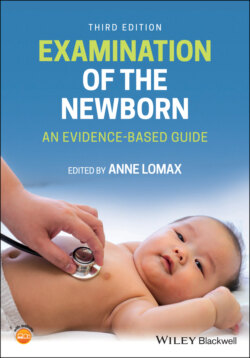Читать книгу Examination of the Newborn - Группа авторов - Страница 37
Risk factors and the newborn examination
ОглавлениеIntergenerational traits may indicate an inheritance risk to the newborn. History taking may elicit such conditions (see Chapter 8). However, they may have already been identified in the prenatal period, particularly the haemoglobinopathies, e.g. thalassaemia or sickle cell disease. The NHS national Antenatal Screening Programme performs well in such cases. The NIPE programme provides seven national risk factors that must be applied to by the NIPE practitioner when performing the newborn examination (PHE 2018a, 2020c). Table 1.4 outlines the four screening components from the NIPE Programme Handbook (PHE 2020c) and conditions that carry a predictive risk, as well as other conditions that may have a positive family trait.
It can be argued that some elements of the newborn screening agenda perform poorly in terms of predictive risk based on clinical examination alone. The newborn examination does have its limitations. The most common example is current screening techniques for congenital heart defects (CHDs) (see also Chapter 2). It is estimated that over half of CHDs are not detected in the newborn period (Wren et al. 2007; Sharland 2010). Despite prenatal cardiac screening as part of the fetal anomaly scan and the clinical cardiovascular assessment at the newborn examination, current methods of detection do not compete on merit as an effective screening tool. This is particularly the case for critical duct‐dependent anomalies (Abu‐Harb et al. 1994; Green and Oddie 2008; Ewer et al. 2012). Sharland (2010) confers that most congenital cardiac anomalies lie within low risk factions. However, a positive family history does correlate with a higher incidence (Romano‐Zelekha et al. 2001).
The use of pulse oximetry may complement the clinical examination and may improve the detection rate of critical CHDs for some newborns. There is increasing evidence to support the use of pulse oximetry as an adjunct to the newborn examination (Knowles et al. 2005; Thangaratinam et al. 2007; Valmari 2007; Ewer et al. 2012), thereby increasing the sensitivity of this screening tool overall. See Chapter 2 for further information on the use of pulse oximetry during the newborn examination.
